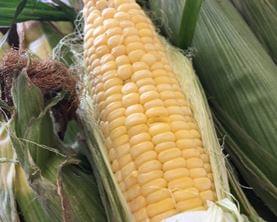One of the highlights of summer is enjoying fresh corn on the cob. Sweet corn is a popular vegetable for many of our summer cookout meals. You will soon be able to find sweet corn available locally in Wayne County.
Even though the specific time of when sweet corn originated cannot be pin-pointed, we know that it was grown by American Indians and was first collected by European settlers in the 1770s.
There are several different types of corn. Field corn was grown in North American before 200 BC. Field corn is produced primarily for animal feed and industrial uses such as ethanol, cooking oil, etc. Sweet corn is produced for human consumption as either fresh or processed products. Sweet corn is a mutant type of corn that differs from field corn by a mutation causing corn kernels to accumulate about two times more sugar than field corn. There are other types of corn grown for popcorn, silage for animal feed, and for corn meal or flour.
Today there are several hundred sweet corn varieties available. Sweet corn varieties come in three colors: yellow, white, and bicolor (yellow and white). Cross-pollination of yellow kernel varieties with white kernel varieties results in production of bicolor corn.
Between 2.2 and 2.9 billion pounds of sweet corn are produced annually in the United States. Over the past ten years, national production of sweet corn has been around 260,000 acres. Nationally, the sweet corn crop is worth $750-850 million per year. Based on value of production, the top five sweet corn states are Florida, California, Washington, New York and Georgia. (Penn State Extension, 2005)
Of the sweet corn produced in United States, 74% was produced for fresh market and 26% for processing (frozen and canned). The production of sweet corn for processing is heavily concentrated in the upper Midwest and the Pacific Northwest. Minnesota, Washington, and Wisconsin are the leading producers of sweet corn for processing. (Agricultural Marketing Resource Center, 2017).
Sweet Corn is usually harvested and available locally in Wayne County in mid to late-June through August. Fresh market sweet corn is traditionally sold from open bulk containers or by the dozen and available at farmers markets, roadside stands, pick-your-own sites and grocery stores
When harvesting or selecting fresh sweet corn, it is important to prevent it from losing sweetness after being harvest. Sweet corn loses sweetness and freshness rapidly after harvest, and the rate of loss increases with increasing temperature. Corn harvested early in the morning will be 10 to 20 degrees cooler than that harvested later in the day. You will want to avoid a long wait between harvesting and consuming or preserving. Sweet corn has a high respiration rate and produces heat which can cause ears to heat up considerably during delays between picking and precooling causing sugar to convert to starch at a more rapid rate.
Be sure to include fresh, local sweet corn with your summer meals and celebrate sweet corn season by purchasing fresh, local sweet corn. Several vendors at the Farm Credit Farmers Market will soon have sweet corn available. The market is open on Thursdays and Fridays from 10am to 5:30pm and Saturdays from 9am to 2pm. The market is located behind The Maxwell Center at 3114 Wayne Memorial Drive, Goldsboro.
Jessica Strickland is an Agriculture Extension Agent, specializing in horticulture for North Carolina Cooperative Extension in Wayne County.


